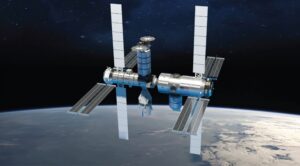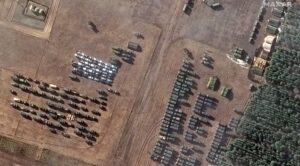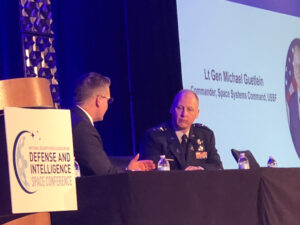Meet the Experts: The James Webb Space Telescope
Thursday, 24 February 2022 08:00 Video:
00:12:24
Video:
00:12:24
Are you curious to know how a telescope works? Join ESA astronomer Giovanna Giardino as she gives an insight into the inner workings of the world’s largest telescope in space, the extraordinary James Webb Space Telescope.
Find more episodes in the Meet the Experts series here.
Ukraine crisis challenges International Space Station cooperation
Thursday, 24 February 2022 05:16 The crisis over Russia's Ukrainian aggression presents NASA and other space agencies with the most serious diplomatic strain in the 22-year history of the International Space Station partnership, experts said.
Russia is a major partner with the United States, Europe, Japan and Canada in the space station's maintenance and operation.
Russia provides critical cargo and crew transport,
The crisis over Russia's Ukrainian aggression presents NASA and other space agencies with the most serious diplomatic strain in the 22-year history of the International Space Station partnership, experts said.
Russia is a major partner with the United States, Europe, Japan and Canada in the space station's maintenance and operation.
Russia provides critical cargo and crew transport, Rocket Lab officially opens third launch pad, Next launch within a week
Thursday, 24 February 2022 05:16 Rocket Lab USA, Inc (Nasdaq: RKLB) has announced the completion of its second orbital launch pad at Launch Complex 1 in New Zealand - the Company's third dedicated pad for its Electron rocket - and confirmed the new pad's first mission will be a dedicated commercial launch scheduled to lift-off within a week's time.
Pad B is based within Rocket Lab Launch Complex 1, the world's first priva
Rocket Lab USA, Inc (Nasdaq: RKLB) has announced the completion of its second orbital launch pad at Launch Complex 1 in New Zealand - the Company's third dedicated pad for its Electron rocket - and confirmed the new pad's first mission will be a dedicated commercial launch scheduled to lift-off within a week's time.
Pad B is based within Rocket Lab Launch Complex 1, the world's first priva Clean driving technology enables cleaner rocket fuel
Thursday, 24 February 2022 05:16 A chemical used in electric vehicle batteries could also give us carbon-free fuel for space flight, according to new UC Riverside research.
In addition to emission reductions, this chemical also has several advantages over other types of rocket fuels: higher energy, lower costs, and no requirement for frozen storage.
The chemical, ammonia borane, is currently used for storing the hyd
A chemical used in electric vehicle batteries could also give us carbon-free fuel for space flight, according to new UC Riverside research.
In addition to emission reductions, this chemical also has several advantages over other types of rocket fuels: higher energy, lower costs, and no requirement for frozen storage.
The chemical, ammonia borane, is currently used for storing the hyd NASA opens second phase of $5 Million Lunar Power Prize Competition
Thursday, 24 February 2022 05:16 Under Artemis, NASA plans to return to the Moon using innovative technologies to explore more of the lunar surface than ever before. This will require lunar surface systems that can deliver continuous, reliable power to support mining and construction, research activities, and human habitation.
The newest phase of NASA's Watts on the Moon Challenge offers up to $4.5 million in prizes to de
Under Artemis, NASA plans to return to the Moon using innovative technologies to explore more of the lunar surface than ever before. This will require lunar surface systems that can deliver continuous, reliable power to support mining and construction, research activities, and human habitation.
The newest phase of NASA's Watts on the Moon Challenge offers up to $4.5 million in prizes to de MIT Lunar Station Corp helps support safe lunar missions
Thursday, 24 February 2022 05:16 This year NASA hopes to return astronauts to the Moon as early as March or April.
Strategically, the Moon has something essential for life in space: water. Lunar ice can supply oxygen for human life and hydrogen fuel for deep space travel. But, navigating the dangerous Lunar surface is not for the faint of heart.
You wouldn't build a home on sand. Would you? The Moon is no differen
This year NASA hopes to return astronauts to the Moon as early as March or April.
Strategically, the Moon has something essential for life in space: water. Lunar ice can supply oxygen for human life and hydrogen fuel for deep space travel. But, navigating the dangerous Lunar surface is not for the faint of heart.
You wouldn't build a home on sand. Would you? The Moon is no differen Thales Alenia Space wins study contract to develop payload to extract Oxygen on the Moon
Thursday, 24 February 2022 05:16 Thales Alenia Space, a joint venture between Thales (67%) and Leonardo (33%), has signed a study contract with the European Space Agency worth one million euros for a payload concept to extract oxygen from Moon rock.
For a sustainable habitation on the Moon, humans will need to utilise resources that they find on the Moon rather than transport these resources from Earth; one of these resou
Thales Alenia Space, a joint venture between Thales (67%) and Leonardo (33%), has signed a study contract with the European Space Agency worth one million euros for a payload concept to extract oxygen from Moon rock.
For a sustainable habitation on the Moon, humans will need to utilise resources that they find on the Moon rather than transport these resources from Earth; one of these resou Sol 3395: Last Chance for Contact
Thursday, 24 February 2022 05:16 Before the science team says "OK TO GO!," today's plan involves getting one of the last looks at the rocks right below the Greenheugh Pediment, some observations at the contact between them, and some higher up on Gediz-Vallis Ridge.
The rover will collect two APXS measurements on "Galdenoch," one a brushed location and another offset from it, including some MAHLI images (see image) to docu
Before the science team says "OK TO GO!," today's plan involves getting one of the last looks at the rocks right below the Greenheugh Pediment, some observations at the contact between them, and some higher up on Gediz-Vallis Ridge.
The rover will collect two APXS measurements on "Galdenoch," one a brushed location and another offset from it, including some MAHLI images (see image) to docu SpaceX to launch IoT tech demo satellites for Plan-S
Thursday, 24 February 2022 05:16 Plan-S Satellite and Space Technologies, a Turkish provider of end-to-end satellite solutions for global IoT services, have signed a series of agreements to launch three IoT tech demo satellites onboard SpaceX's Falcon 9 via Exolaunch, a global leader in launch, in-space logistics and deployment services for small satellites. The satellites being built by Plan-S will be launched in the second ha
Plan-S Satellite and Space Technologies, a Turkish provider of end-to-end satellite solutions for global IoT services, have signed a series of agreements to launch three IoT tech demo satellites onboard SpaceX's Falcon 9 via Exolaunch, a global leader in launch, in-space logistics and deployment services for small satellites. The satellites being built by Plan-S will be launched in the second ha Robotic cubes shapeshift in outer space
Thursday, 24 February 2022 05:16 If faced with the choice of sending a swarm of full-sized, distinct robots to space, or a large crew of smaller robotic modules, you might want to enlist the latter. Modular robots, like those depicted in films such as "Big Hero 6," hold a special type of promise for their self-assembling and reconfiguring abilities. But for all of the ambitious desire for fast, reliable deployment in domains ex
If faced with the choice of sending a swarm of full-sized, distinct robots to space, or a large crew of smaller robotic modules, you might want to enlist the latter. Modular robots, like those depicted in films such as "Big Hero 6," hold a special type of promise for their self-assembling and reconfiguring abilities. But for all of the ambitious desire for fast, reliable deployment in domains ex Northrop Grumman awarded US Space Force contract for deep-space advanced radar
Thursday, 24 February 2022 05:16 Northrop Grumman Corporation has been awarded a $341 million contract by the U.S. Space Force (USSF) Space Systems Command (SSC) to develop, test and deliver a Deep-Space Advanced Radar Capability (DARC) in support of its Space Domain Awareness mission.
"The DARC program will field a resilient ground-based radar providing our nation with significantly enhanced space domain awareness for ge
Northrop Grumman Corporation has been awarded a $341 million contract by the U.S. Space Force (USSF) Space Systems Command (SSC) to develop, test and deliver a Deep-Space Advanced Radar Capability (DARC) in support of its Space Domain Awareness mission.
"The DARC program will field a resilient ground-based radar providing our nation with significantly enhanced space domain awareness for ge New power sources
Thursday, 24 February 2022 05:16 In the mid-1990s, a few energy activists in Massachusetts had a vision: What if citizens had choice about the energy they consumed? Instead of being force-fed electricity sources selected by a utility company, what if cities, towns, and groups of individuals could purchase power that was cleaner and cheaper?
The small group of activists - including a journalist, the head of a small nonprof
In the mid-1990s, a few energy activists in Massachusetts had a vision: What if citizens had choice about the energy they consumed? Instead of being force-fed electricity sources selected by a utility company, what if cities, towns, and groups of individuals could purchase power that was cleaner and cheaper?
The small group of activists - including a journalist, the head of a small nonprof ISS transition to commercial stations poses challenges for partners
Wednesday, 23 February 2022 23:09
NASA’s plans to shift from the International Space Station to commercial space stations may force one key partner to rethink how it cooperates in low Earth orbit.
The post ISS transition to commercial stations poses challenges for partners appeared first on SpaceNews.
U.S. and Europe say space cooperation with Russia not affected yet by Ukraine crisis
Wednesday, 23 February 2022 21:38
American and European officials said Feb. 23 that space cooperation with Russia remains unaffected even as that country continues to threaten a full-scale invasion of Ukraine.
The post U.S. and Europe say space cooperation with Russia not affected yet by Ukraine crisis appeared first on SpaceNews.
Space Force procurement command trying to bring ‘unity of effort’ to space programs
Wednesday, 23 February 2022 21:24
Claire Leon, a former Boeing executive who previously led the national security space launch program, is now in charge of a new office that will coordinate military space programs.
The post Space Force procurement command trying to bring ‘unity of effort’ to space programs appeared first on SpaceNews.

